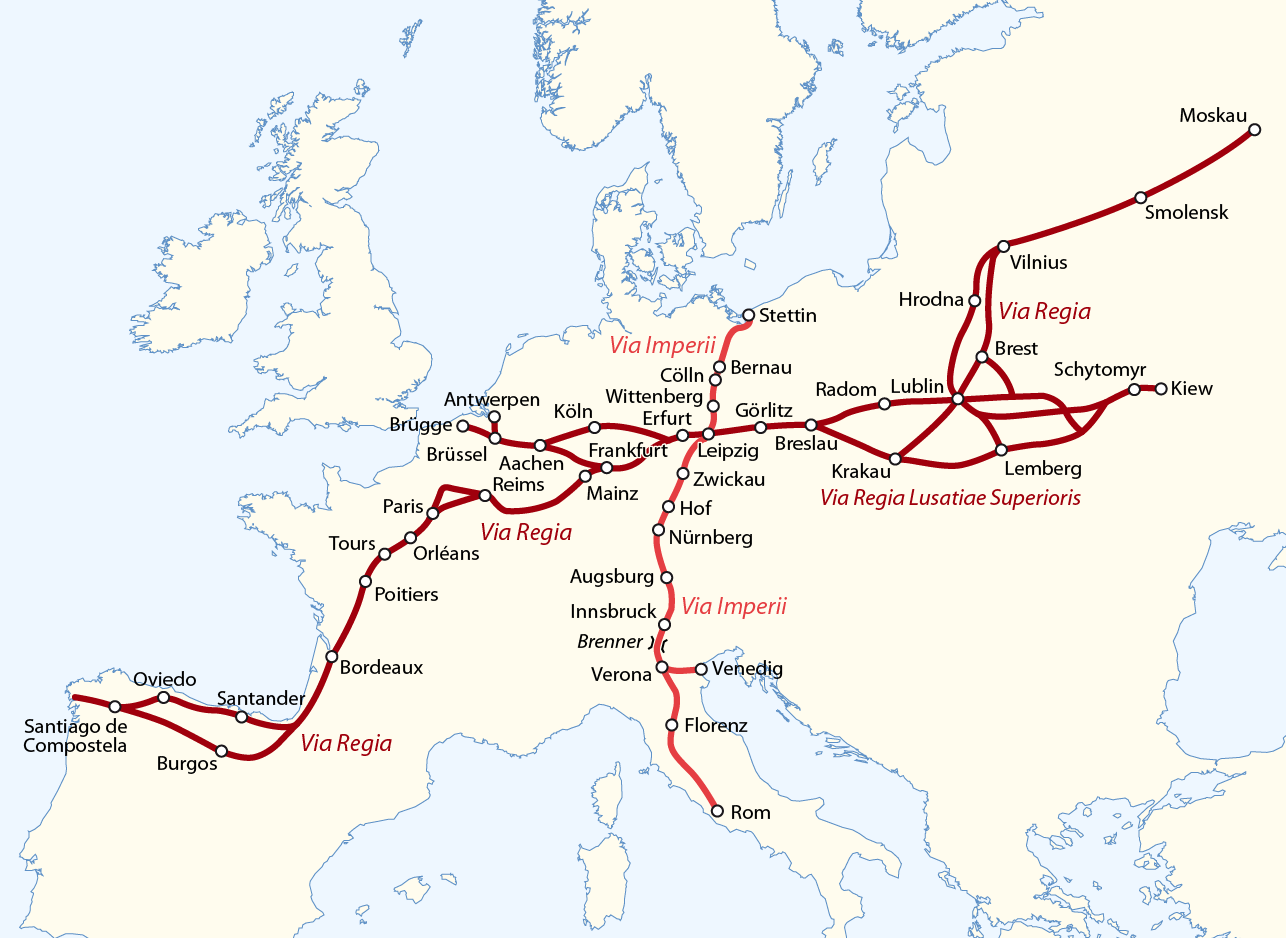Imperial Road on:
[Wikipedia]
[Google]
[Amazon]
 In
In
 In
In medieval
In the history of Europe, the Middle Ages or medieval period lasted approximately from the 5th to the late 15th centuries, similarly to the post-classical period of World history (field), global history. It began with the fall of the West ...
times, imperial roads () were designated routes in the Holy Roman Empire
The Holy Roman Empire, also known as the Holy Roman Empire of the German Nation after 1512, was a polity in Central and Western Europe, usually headed by the Holy Roman Emperor. It developed in the Early Middle Ages, and lasted for a millennium ...
that afforded protection to travellers in return for tolls collected for the emperor.
The ''Reichsstraßen'' came under royal jurisdiction ('' Königsbann'') and travellers were afforded the protection of the ''Landfrieden
Under the law of the Holy Roman Empire, a ''Landfrieden'' or ''Landfriede'' (Latin: ''constitutio pacis'', ''pax instituta'' or ''pax jurata'', variously translated as "land peace", or "public peace") was a contractual waiver of the use of legiti ...
'', a law that was supposed to ensure peace and unhindered passage similar to the Queen's peace. From the 10th century it was also extended to bridges and ferries. Under King Henry I of Germany the term ''Reichsstrasse'' (''des riches strâze'' in Middle High German
Middle High German (MHG; or ; , shortened as ''Mhdt.'' or ''Mhd.'') is the term for the form of High German, High German language, German spoken in the High Middle Ages. It is conventionally dated between 1050 and 1350, developing from Old High ...
) was used for the first time as a translation of ''strata imperialis''.
According to Charlemagne
Charlemagne ( ; 2 April 748 – 28 January 814) was List of Frankish kings, King of the Franks from 768, List of kings of the Lombards, King of the Lombards from 774, and Holy Roman Emperor, Emperor of what is now known as the Carolingian ...
's legislation, based on Gallic public law
Public law is the part of law that governs relations and affairs between legal persons and a government, between different institutions within a state, between different branches of governments, as well as relationships between persons that ...
, the maintenance of roads, the responsibility for transport infrastructure and security were part of the duties and privileges of the king, his "regalia
Regalia ( ) is the set of emblems, symbols, or paraphernalia indicative of royal status, as well as rights, prerogatives and privileges enjoyed by a sovereign, regardless of title. The word originally referred to the elaborate formal dress and ...
". In return the king received the taxes
A tax is a mandatory financial charge or levy imposed on an individual or legal entity by a governmental organization to support government spending and public expenditures collectively or to regulate and reduce negative externalities. Tax co ...
. He invested the territorial rulers through whose lordships the roads ran, with the execution of these duties. A safe-conduct letter (''tote Geleit'') or an armed escort (''lebende Geleit''), ensured the safety of the travellers. The escort was provided on specified occasions, of which travelling to the election and coronation of Roman-German kings and emperors was the most important, whereas travelling to trade fair
A trade show, also known as trade fair, trade exhibition, or trade exposition, is an exhibition organized so that companies in a specific Industry (economics), industry can showcase and demonstrate their latest Product (business), products and se ...
s and markets were the most common.
Important imperial roads were the north-south Via Imperii
Via Imperii (Imperial Road) was one of the most important of a class of roads known collectively as imperial roads (') of the Holy Roman Empire. This old trade route ran in a south–north direction from Venice on the Adriatic Sea and Verona i ...
and the east-west Via Regia
The Via Regia (Royal Highway) is a European Cultural Route following the route of the Historic roads, historic road of the Middle Ages. There were many such ''viae regiae'' associated with the king in the medieval Holy Roman Empire.
History ...
meeting at Leipzig
Leipzig (, ; ; Upper Saxon: ; ) is the most populous city in the States of Germany, German state of Saxony. The city has a population of 628,718 inhabitants as of 2023. It is the List of cities in Germany by population, eighth-largest city in Ge ...
, as well as the Via Carolina from the Imperial city of Nuremberg
Nuremberg (, ; ; in the local East Franconian dialect: ''Nämberch'' ) is the Franconia#Towns and cities, largest city in Franconia, the List of cities in Bavaria by population, second-largest city in the States of Germany, German state of Bav ...
to Prague
Prague ( ; ) is the capital and List of cities and towns in the Czech Republic, largest city of the Czech Republic and the historical capital of Bohemia. Prague, located on the Vltava River, has a population of about 1.4 million, while its P ...
established by Emperor Charles IV, the Hellweg, the Burgundy Way and Italian Way/Via Francigena
The Via Francigena (), also known as Francisca or Romea, is an ancient road and Christian pilgrimage, pilgrimage route running from the City status in the United Kingdom#Cathedral towns, cathedral city of Canterbury in England, through France and ...
.
References
{{Reflist Medieval roads and tracks Economy of the Holy Roman Empire Historic trails and roads in Germany